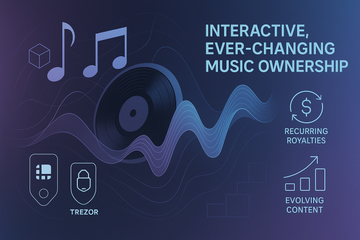Picture this: you snag a rare digital album, but instead of gathering dust in a virtual stack, it keeps changing, evolving, even responding to your engagement. That’s the vibe with dynamic music data NFTs—a fresh twist to digital collectibles, merging blockchain’s authenticity with music that doesn’t want to stand still. If you’re curious about where music, technology, and crypto hardware wallets like Trezor or Ledger intersect, well, you’re in for a treat. Let’s take a stroll through this new digital soundscape.
So, What’s the Big Deal with Dynamic Music NFTs?
You know, regular music NFTs—think a rare single, a digital poster, or a behind-the-scenes video—are a bit like digital keepsakes. They’re cool and all, but they’re frozen in time. Now, dynamic music data NFTs are shaking things up. Instead of staying static, they can change their content or characteristics based on certain triggers. Maybe an artist releases a secret track if enough fans participate. Or perhaps the artwork morphs after a live gig. It’s not just about ownership anymore; it’s about being a part of the unfolding story.
Under the Hood: How Do They Even Work?
Let me explain. These dynamic music NFTs hang their hats on programmable smart contracts. Imagine a digital container that isn’t sealed—one that can open new compartments depending on what you do or what’s happening in the world. For instance, buy an album NFT today, and six months later, a special remix drops directly into it, automatically. Or, maybe the song adapts—maybe the tempo changes if a thousand people stream it during a full moon. Sounds wild, but it’s all about updating metadata dynamically based on preset conditions. Pretty futuristic, right?
Why All This Hype: What’s in It for Artists and True Fans?
Honestly, there’s more than meets the ear. Artists suddenly hold the keys to futuristic fan engagement. Let’s break it down:
- Ongoing Revenue: Instead of a one-time sale, dynamic NFTs can trigger recurring royalties—think, every time new content is unlocked, creators get paid. No more playing second fiddle to middlemen.
- Creative Playground: With platforms offering features like multi-track capabilities, musicians can experiment. Maybe one NFT holds an entire evolving album, releasing bits over time, keeping fans coming back for more.
- Genuine Connection: Fans become part of the show, not just passive listeners. Imagine being one of 500 NFT holders to unlock a never-before-heard acoustic set. That feels special, doesn’t it?
These perks go both ways—artists find fresh income streams, and fans get bragging rights (plus a deeper connection).
So, Where Are These NFTs Actually Living?
Security is a biggie in crypto, especially when we’re talking about stuff as coveted as limited-edition music data NFTs. That’s where crypto hardware wallets like Trezor and Ledger step into the limelight. These aren’t just gadgets for storing Bitcoin. They offer the kind of safe-deposit-box security that collectors and creators both crave. In fact, Ledger even has resources about storing and interacting with dynamic music NFTs securely. If you don’t want that one-of-a-kind album lost to a phishing scam, well, hardware wallets are your best mate.
Not Just Music, Not Just NFTs—It’s a Whole New Playground
What can you actually do with these? Let’s chew on a few ideas:
- Morphing Albums: Imagine a record where new tracks emerge over months (or years!), or the art evolves as listeners participate in virtual events.
- Concert Keepsakes: Grab an NFT ticket that unlocks backstage footage or soundboard recordings only if you prove you were in the crowd.
- Generative Sound: Some dynamic NFTs play music that shifts based on weather data, blockchain stats, or even your own listening history. Wild stuff for future audiophiles!
Some platforms, like Itheum, are experimenting with these so-called ‘multi-track NFTs’ and generative experiences, giving power back to artists and fans, not middlemen or algorithms.
But Wait—What’s the Catch?
Every silver lining has a cloud or two, right? The technology isn’t exactly seamless yet. Artists need accessible tools and support (which, thankfully, some projects like Itheum or Ledger Academy have started offering). There are also questions about long-term value. Will a dynamic NFT from your favorite band mean as much in five years? Or will it feel like digital clutter—yet another fleeting trend?
And who decides what content unlocks or how it evolves? If that’s not handled transparently, even the coolest tech can leave fans scratching their heads or, worse, feeling ripped off. Security, too, is a hurdle—hence the rising interest in hardware wallets to keep your digital music gems safe from lurking scammers.
The Big Picture: Not Just Another “Crypto Craze”
The way I see it, dynamic music data NFTs aren’t just a techy fad. They’re a response to something real—both artists and fans want more connection, more ownership, and more excitement. And whether you store them in a Ledger, a Trezor, or a digital gallery, these assets have the potential to be as dynamic as the music they contain.
Of course, nothing’s perfect. It’ll take time for creators, platforms, and collectors to work out what really resonates. But you know what? We’re all co-writing this new chapter. Next time you hear that NFT buzz, just remember—sometimes, the most interesting tracks are the ones still being written.











